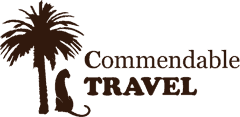
Day 1-3: Johannesburg (province of Gauteng)
The natural landscape around Johannesburg gives no hint as to why the most important business centre on the African continent should be here. It is only the “mine dumps”, the residue of deep underground mining, that gives the game away. The richest gold deposits in the world were the reason for the existence of Johannesburg, and while today gold is far less important in the economic life of South Africa, its legacy lives on in this thriving metropolis that remains the commercial capital of the country. As an essential element to understanding the foundation and the challenges of today’s South Africa, we have organized a three night program.
Day 1. As most of you will have come a long distance, we view that first day as one of relaxation and recovery from your travels. For those not wishing to sleep, swim or play tennis, we will happily arrange a brief tour of the city. There will be a casual supper at the hotel. We will be staying at the The Residence, a boutique Hotel set in gardens in Houghton, the area of Johannesburg represented in parliament for 36 years by the redoubtable Helen Suzman.
Day 2. The next day we will visit the capital city, Pretoria, seeing the Voortrekker Monument, the Union Buildings (the seat of Government) and the Cullinan Diamond Mine, the source of the largest gem diamond in the world as well as a number of the other diamonds in the British Crown Jewels. That evening we will have a dinner with some notable South Africans, most likely including some with involvement in De Beers.
Day 3. The following day we will visit the Brenthurst Library, created by Harry Oppenheimer to house, inter alia, his collection of “Africana”, and will visit the remarkable gardens as well. After lunch, we will visit the Apartheid Museum, and/or the Hector Peterson Museum in Soweto. For those who have already visited these places in earlier travels with us, there will be a separate tour to the new “Museum Africa”, and to the “Credo Mutwa” Cultural Village and the Oppenheimer Tower in Soweto. The evening may include a play at the historic “Market Theatre”.
Day 1. As most of you will have come a long distance, we view that first day as one of relaxation and recovery from your travels. For those not wishing to sleep, swim or play tennis, we will happily arrange a brief tour of the city. There will be a casual supper at the hotel. We will be staying at the The Residence, a boutique Hotel set in gardens in Houghton, the area of Johannesburg represented in parliament for 36 years by the redoubtable Helen Suzman.
Day 2. The next day we will visit the capital city, Pretoria, seeing the Voortrekker Monument, the Union Buildings (the seat of Government) and the Cullinan Diamond Mine, the source of the largest gem diamond in the world as well as a number of the other diamonds in the British Crown Jewels. That evening we will have a dinner with some notable South Africans, most likely including some with involvement in De Beers.
Day 3. The following day we will visit the Brenthurst Library, created by Harry Oppenheimer to house, inter alia, his collection of “Africana”, and will visit the remarkable gardens as well. After lunch, we will visit the Apartheid Museum, and/or the Hector Peterson Museum in Soweto. For those who have already visited these places in earlier travels with us, there will be a separate tour to the new “Museum Africa”, and to the “Credo Mutwa” Cultural Village and the Oppenheimer Tower in Soweto. The evening may include a play at the historic “Market Theatre”.
Day 4-5: Kwa Zulu-Natal (Spioenkop)
Day 4. Called “The Garden Province” for its extensive flora, this is certainly one of the most scenic parts of South Africa. We will drive there through the flat farmlands of the Gauteng and Free State highveld until the northern reaches of the Drakensberg mountains come into view. We will have lunch at Ladysmith, famous for its siege during the Second Anglo-Boer War, and take advantage of visiting the local museum.
After that we will go to the Three Trees Lodge at Spioenkop for two nights. Owned by Simon and Cheryl Blackburn who have many years of experience in lodge and wildlife management, this is a small lodge that captures the ambiance of the Victorian era that was of such significance to the history of the area.
Day 5. The next day, we can go Rhino Tracking on foot in the adjacent Reserve or visit the Spioenkop Anglo-Boer War Battlefield with Simon, or just go for walks on the farm or use the mountain bikes. If their schedule permits, we may go to attend a concert of the famous Drakensberg Boys Choir.
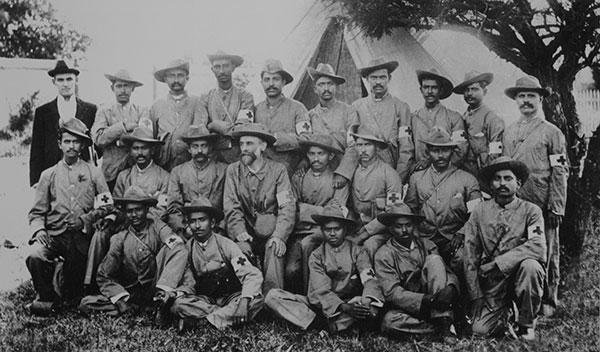
After that we will go to the Three Trees Lodge at Spioenkop for two nights. Owned by Simon and Cheryl Blackburn who have many years of experience in lodge and wildlife management, this is a small lodge that captures the ambiance of the Victorian era that was of such significance to the history of the area.
Day 5. The next day, we can go Rhino Tracking on foot in the adjacent Reserve or visit the Spioenkop Anglo-Boer War Battlefield with Simon, or just go for walks on the farm or use the mountain bikes. If their schedule permits, we may go to attend a concert of the famous Drakensberg Boys Choir.

Gandhi in Boer War
Day 6-8: Kwa Zulu-Natal (Kosi Bay)
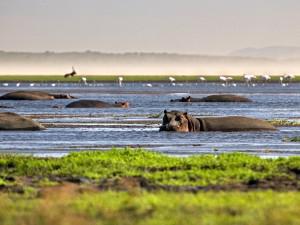 Day 6. We can spend this morning horse-riding or hiking or bird-watching on the property, have a light lunch at the lodge and then go to Ladysmith to take a private aircraft to the northern coastal reaches of the Province, to a landing strip in Northern Zululand from which we will be transported in 4 wheel drive vehicles to Kosi Forest Lodge, a past favourite. The five interlocking lakes of the Kosi Bay area represent an unique and fascinating ecological site. Our accommodation in separate huts, complete with exterior shower and tub, will remind you that you are in Africa! That evening we will dine under the stars, and hope to catch a glimpse of an adorable bush baby in the trees, and enjoy some local entertainment.
Day 6. We can spend this morning horse-riding or hiking or bird-watching on the property, have a light lunch at the lodge and then go to Ladysmith to take a private aircraft to the northern coastal reaches of the Province, to a landing strip in Northern Zululand from which we will be transported in 4 wheel drive vehicles to Kosi Forest Lodge, a past favourite. The five interlocking lakes of the Kosi Bay area represent an unique and fascinating ecological site. Our accommodation in separate huts, complete with exterior shower and tub, will remind you that you are in Africa! That evening we will dine under the stars, and hope to catch a glimpse of an adorable bush baby in the trees, and enjoy some local entertainment.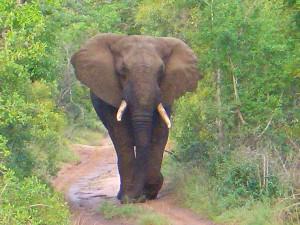 Day 7. After a hearty breakfast the next morning, we will head off to the nearest lake and take a shallow-bottomed covered boat through the lake system as far as time allows, taking a close look at the Raffia forest, wallowing hippos and soaring Fish Eagles, and marveling at the ancient fishing traps still used by local fisherman. We might have to get into the crystal clear water to lessen the draught, to allow the boat to pass over the sometimes shallow crossings between the lakes. We will take a picnic lunch with us to enjoy this idyll as long as possible. The following morning we might do a little canoeing or a stroll through the amazing Raffia forest before lunch, and after lunch, we will once again get into 4-wheel drive vehicles and head off for the real wildlife!
Day 7. After a hearty breakfast the next morning, we will head off to the nearest lake and take a shallow-bottomed covered boat through the lake system as far as time allows, taking a close look at the Raffia forest, wallowing hippos and soaring Fish Eagles, and marveling at the ancient fishing traps still used by local fisherman. We might have to get into the crystal clear water to lessen the draught, to allow the boat to pass over the sometimes shallow crossings between the lakes. We will take a picnic lunch with us to enjoy this idyll as long as possible. The following morning we might do a little canoeing or a stroll through the amazing Raffia forest before lunch, and after lunch, we will once again get into 4-wheel drive vehicles and head off for the real wildlife!You will awake around 5 am on Day 8 for the morning game drive, returning for breakfast. Afterwards, there is total relaxation around the pool, or elsewhere, until a light lunch. The afternoon game drive starts around 5h30 pm, and lasts approximately 3 hours, which includes “Sundowners” in the bush as the sun is setting. Returning to the lodge, dinner is taken either at the lodge or in the “Boma”, the traditional outdoor dining around a camp fire in a structure protected from wild animals.
Day 8-11: Kwa Zulu-Natal (Africa's Wildlife)
Days 8, 9, & 10. For the next three days, we will luxuriate among the best of Africa’s wildlife, either at the Phinda Reserve (AndBeyond’s first property) or at the Amakhosi Reserve. These two reserves are not too far apart, and both provide a fabulous wildlife experience. Once inside the reserve all movement is by Land Rover, or on foot accompanied by an armed ranger. This is one of the finest wildlife places in the country.
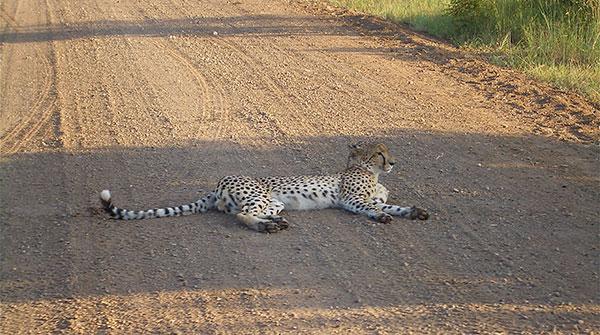
Day 11. We depart our Game Lodge after breakfast and drive to Durban, past sugar cane fields and sub-tropical vegetation. We will stop en-route for a lunch before arriving at Umhlanga Rocks, just north of Durban, where we will be staying at The Oyster Box, a famous Five Star hotel overlooking the Indian Ocean. After a stroll along the beach, a fresh seafood dinner will be the perfect topper.
Day 12-13: Kwa Zulu-Natal (Durban)
Day 12. The next day we will visit the City of Durban in the morning – the sea front, the port, possibly the Shark Research Institute, and the Bird Sanctuary before having lunch at the Durban Country Club, the site of more South African Open Golf Tournaments than any other location. In the afternoon, we may visit the Indian community’s Phoenix Settlement, created by Mahatma Ghandi. That evening there will be a dinner with invited guests so that you can learn more about the Province of Kwa Zulu-Natal.
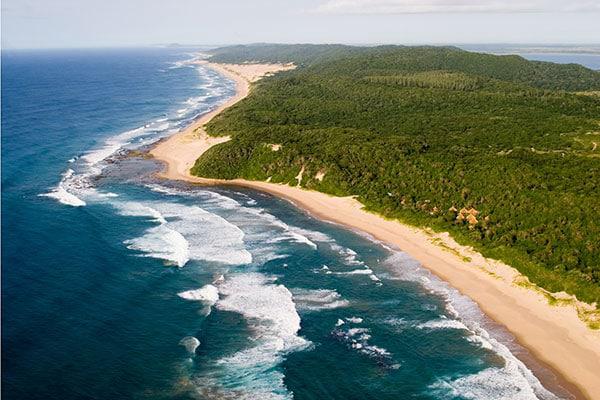

Day 13. We will take a morning flight to George, in the east of the Western Cape Province. Any guests departing for international destinations will fly to Johannesburg in the afternoon for their return international flights.
